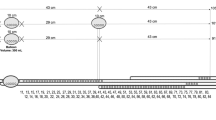Abstract
Patients with obstructed defecation show no consistent abnormalities when assessed by standard anorectal physiologic methods. With a recently developed technique for dynamic anal manometry, we studied 13 female patients with obstructed defecation and 20 healthy volunteers. Seven parameters of anal function were measured. There were no differences between the median values for the two groups. Seven patients (54 percent; 95 percent confidence limits, 25–81 percent) had anal compliance below the normal range, either during opening or closing of the sphincter at rest (five patients), during squeeze (one patient), or both (one patient). Opening and closing pressures of the sphincer at rest, maximal closing pressure during squeeze, and anal hysteresis were normal. Standard anal manometry did not show any differences between patients and controls. Rectal compliance was lower in patients with obstructed defecation, median difference 5 ml/cm H 2 O (95 percent confidence limits, 1–9 ml/cm H 2 O). In conclusion, the more detailed method of dynamic anal manometry shows that some patients with obstructed defecation have a less compliant anal sphincter and a less compliant rectum, but in many patients no abnormal findings can be made.
Similar content being viewed by others
References
Read NW, Timms JM, Barfield LJ, Donelly TC, Bannister JJ. Impairment of defecation in young women with severe constipation. Gastroenterology 1986;90: 53–60.
Shouler P, Keighley MR. Changes in colorectal function in severe idiopathic chronic constipation. Gastroenterology 1986;90:414–20.
Roe AM, Bartolo DC, Mortensen NJ. Diagnosis and surgical management of intractable constipation. Br J Surg 1986;73:854–61.
Varma JS, Smith AN. Neurophysiological dysfunction in young women with intractable constipation. Gut 1988;29:963–8.
Wald A, Caruna BJ, Freimanis MG, Bauman DH, Hinds JP. Contributions of evacuation proctography and anorectal manometry to evaluation of adults with constipation and defecatory difficulty. Dig Dis Sci 1990;35:481–8.
Miller R, Duthie GS, Bartolo DC, Roe AM, Locke-Edmunds J, Mortensen NJ. Anismus in patients with normal and slow transit constipation. Br J Surg 1991;78:690–2.
Jones PN, Lubowski DZ, Swash M, Henry MM. Is paradoxical contraction of puborectalis muscle of functional importance. Dis Colon Rectum 1987;30: 667–70.
Rasmussen OØ, Colstrup H, Lose G, Christiansen J. A technique for the dynamic assessment of anal sphincter function. Int J Colorectal Dis 1990;5: 135–41.
Rasmussen OØ Sørensen M, Tetzschner T, Christiansen J. Dynamic anal manometry: physiological variations and pathophysiological findings in fecal incontinence. Gastroenterology 1992;103:103–13.
Skomorowska E, Henrichsen S, Christiansen J, Hegedus V. Videodefaecography combined with measurement of the anorectal angle and of perineal descent. Acta Radiol 1987;28:559–62.
Turnbull GK, Bartram CI, Lennard-Jones JE. Radiologic studies of rectal evacuation in adults with idiopathic constipation. Dis Colon Rectum 1988;31: 190–7.
Harris JH, Therkelsen EE, Zinner NR. Electrical measurements of ureteral flow. In: Boyarsky S, Gottschalk CW, Tanagho EM, Zimskind PD, eds. Urodynamics. New York: Academic Press, 1971:465–72.
Krogh Petersen I, Christiansen J. A study of the physiological variation in anal manometry. Br J Surg 1989;76:69–70.
Rasmussen OØ, Christensen B, Sørensen M, Tetzschner T, Christiansen J. Rectal compliance in the assessment of patients with fecal incontinence. Dis Colon Rectum 1990;33:650–3.
Gardner MJ, Altman DG. Statistics with confidence. London: British Medical Journal Publishers, 1989.
Gibbons CP, Bannister JJ, Read NW. Role of constipation and anal hypertonia in the pathogenesis of haemorrhoids. Br J Surg 1988;75:656–60.
Martelli H, Devroede G, Arhan P, Duguay C. Mechanisms of idiopathic constipation: outlet obstruction. Gastroenterology 1978;75:623–31.
Pinho M, Yoshioka K, Keighley MR. Long term results of anorectal myectomy for chronic constipation. Br J Surg 1989;76:1163–4.
Dahl J, Lindquist BL, Tysk C, Leissner P, Philipson L, Jarnerot G. Behavioral medicine treatment in chronic constipation with paradoxical anal sphincter contraction. Dis Colon Rectum 1991;34:769–76.
Fleshman JW, Dreznik Z, Meyer K, Fry RD, Carney R, Kodner IJ. Outpatient protocol for biofeedback therapy of pelvic floor outlet obstruction. Dis Colon Rectum 1992;35:1–7.
Wexner SD, Cheape JD, Jorge JM, Heymen S, Jagelman DG. Prospective assessment of biofeedback for the treatment of paradoxical puborectalis contraction. Dis Colon Rectum 1992;35:145–50.
Author information
Authors and Affiliations
About this article
Cite this article
Rasmussen, O.Ø., Sørensen, M., Tetzschner, T. et al. Dynamic anal manometry in the assessment of patients with obstructed defecation. Dis Colon Rectum 36, 901–907 (1993). https://doi.org/10.1007/BF02050623
Issue Date:
DOI: https://doi.org/10.1007/BF02050623




